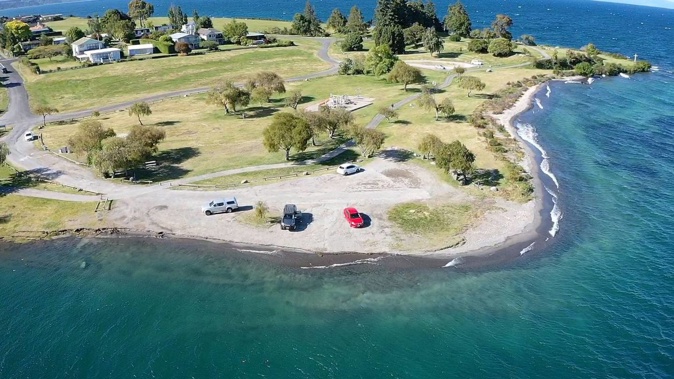
Scientists say heavy rain and ground saturation in Taupō before an earthquake and small tsunami may have contributed to foreshore damage.
GNS Science has kept Lake Taupō at alert level 1 alert, after the 5.6 magnitude quake just before midnight on November 30.
“The activity is consistent with ongoing minor volcanic unrest at Taupō volcano,” GNS said in a statement, referring to hundreds of minor earthquakes recorded since May this year.
Swarms of earthquakes under the lake were quite common.
Following the swarm of aftershocks the next morning, and a wave that swept into Tapuaeharuru Bay, a 30m section of beach at Four Mile Bay in Wharewaka dropped into the water.
The wave also swept two boats on to rocks, despite being pulled up well away from the water’s edge and secured with chains.
GNS Science senior volcanologist Geoff Kilgour said they were still investigating the cause of the foreshore damage, and there had been further reports from around the lake.
He said they had measured 250mm of horizontal movement of the lake bed towards the southeast at Horomatangi Reef beneath Taupō where the quakes have been centred. More than 600 aftershocks have been recorded following the November 30 quake.
“We are actively looking into the source process(es) of the small tsunami that occurred during the earthquake, and the localised sections of the lake shore collapse. Survey respondents have also helped us focus on other lakeshore areas that we are actively investigating with field team surveys.”
He said the lake was safe to swim in at Wharewaka, but people should act quickly if they notice anything unusual.
The Taupō District Council has fenced off the car park closest to the collapse to ensure the weight of vehicles does not cause it to collapse further and are asking people to “keep themselves, their children and their vehicles well back from the edge”.
“Earthquake and landslide activity can cause tsunami, even in a lake. If people at the lake edge feel strong ground shaking, hear a loud boom, or notice unusual lake conditions, they should act immediately and move to higher ground as soon as it is safe to do so,” Kilgour said.
/cloudfront-ap-southeast-2.images.arcpublishing.com/nzme/2SYTV25VXZBGBJCIBKTSSDE4CU.jpg)
Owners of Taupō Paddle Boats Kiripati Bowden and Jess Ratana haul their paddle boats out of the water at Four Mile Bay Taupō after a lake surge washed them off the shore as a result of the earthquake. Photo / Dan Hutchinson
Taupō Pedal Boats owners Jess Ratana and Kiripiti Bowden were down at the lake’s edge the morning after the November 30 quake, pulling the two four-person pedal boats off the rocks with a 4WD ute.
Ratana said they were fortunate all of their pedal bikes were intact but the larger pedal boats were the only two they had.
“We pulled them right up last week because of the wind. It was really windy down here. They were on the grass, they weren’t really near the water at all.
“It’s just pulled them out and the wind direction has taken them this way and they have ended up being smashed against the rocks.”
She said they were insured but it would take months to get replacements, meaning they would miss the main summer holiday season. “It’s not something we ever thought would happen — an earthquake, and a lake tsunami. I don’t think anyone would have expected that.”
Kilgour said field teams have been using drone footage and surveying techniques to measure localised lake shore slumping and tsunami inundation, with locations of investigation guided by information from the public.
“The position of pumice strandlines at Wharewaka Point appears to show the largest tsunami inundation, measured at 40 metres inland.
“Wave action is likely the result of at least one tsunami, however, we are still assessing their causes. More analysis of existing data, coupled with additional field survey results, should enable our experts to develop models of what happened.
He said the magnitude and rate of aftershocks had started to decline but were expected to continue for several weeks.
“Within the next 30 days, there is a 16 per cent chance of one or more earthquakes of M5 or larger.”
The ground deformation and earthquake activity were likely caused by magma and hydrothermal fluids deep beneath Taupō volcano.
“This period of unrest is one of at least 17 previous episodes at Taupō over the past 150 years. None of those unrest periods resulted in an eruption and the activity observed last week appears no different.”
To assess any broad-scale change at the volcano, Kilgour said they had sampled the geothermal gases at Motuoapa.
“That area appears unchanged from our last sampling survey in September. We are proceeding with installation of additional seismic and GNSS instruments to enhance our data capture. When the weather allows, we will be conducting a lake levelling survey that will complement the results from our analysis of GNSS data.
“Previous unrest at Taupō has continued for months to years. Based on this history, the current unrest period could continue for many weeks to months at varying rates or intensities.
“Moderate to large earthquake activity can cause landslides into the lake, slumping of steep under water slopes and displacement of the lake floor due to faulting, all of which can generate unusual wave activity.”
He said tsunami or unusual waves in lakes are also known as seiches.
“We understand that the earthquakes and tsunami recorded over the last week can be unsettling for some, but the activity we have seen is within the bounds expected during a period of minor unrest at Taupō. We continue to closely monitor the volcano, and when we have more information, we will share this.”
- Dan Hutchinson, Rotorua Daily Post
Take your Radio, Podcasts and Music with you









